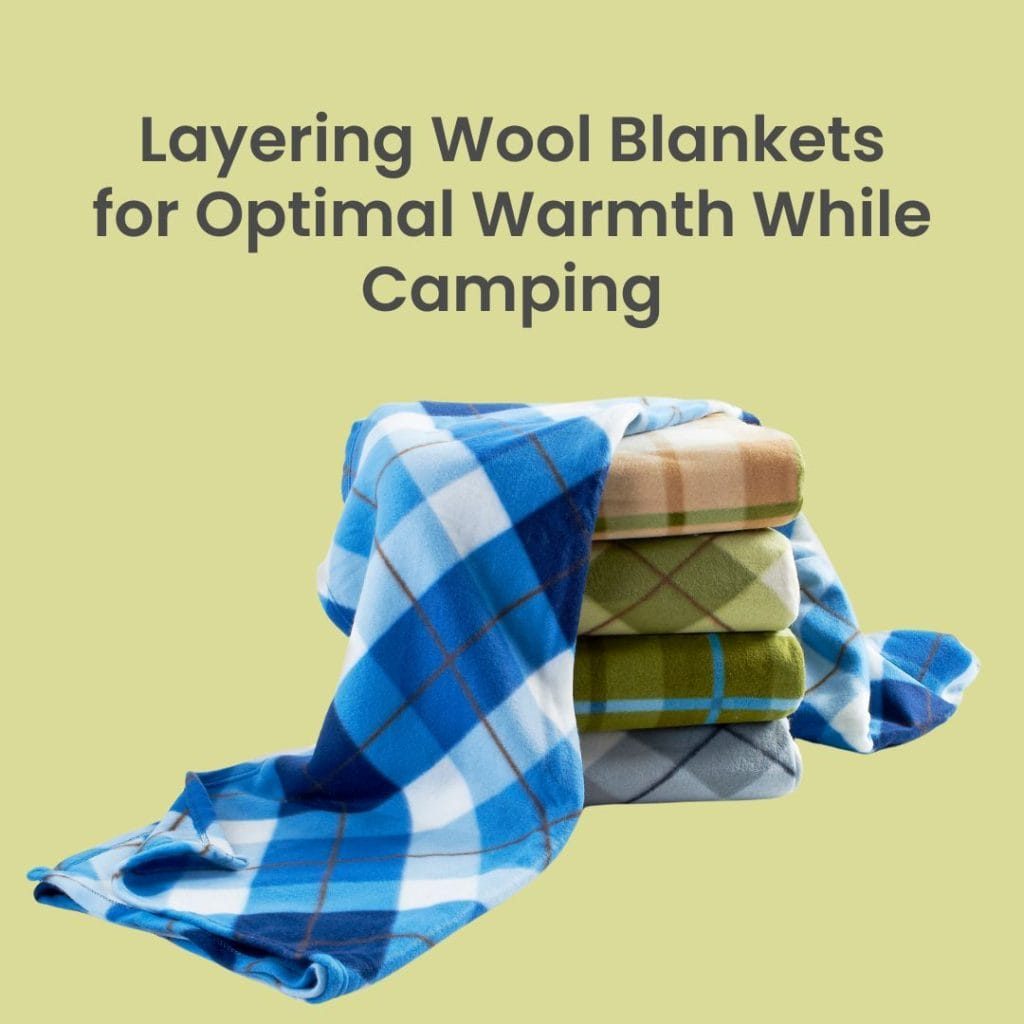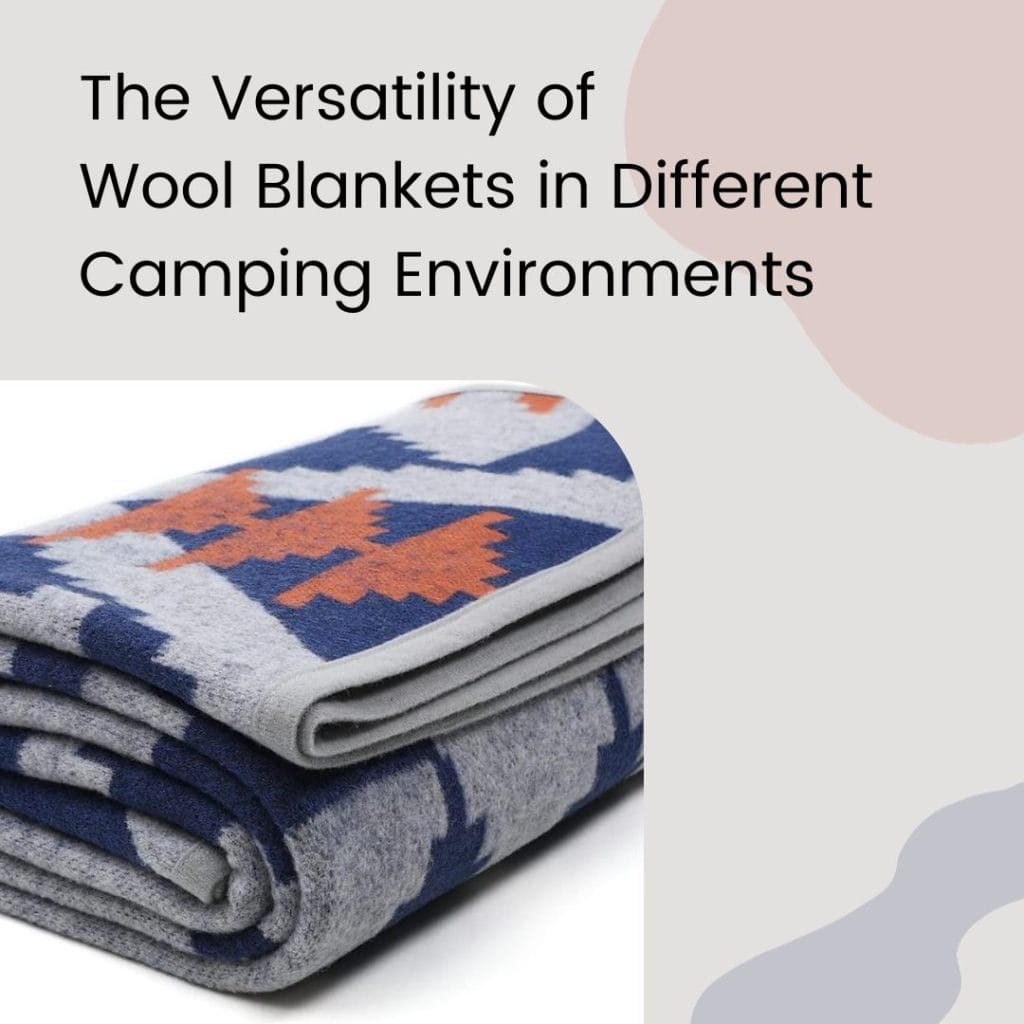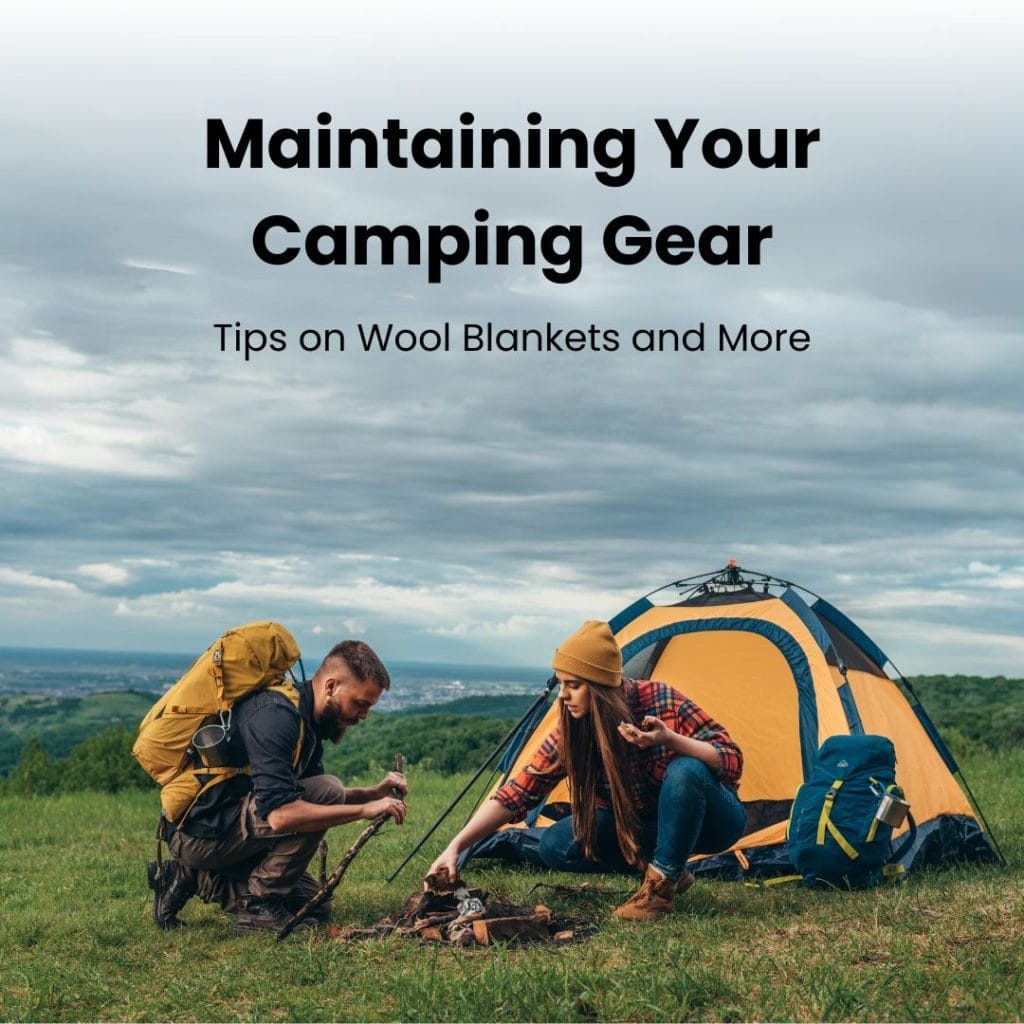Welcome to “Maintaining Your Camping Gear: Tips on Wool Blankets and More,” your comprehensive guide to prolonging the life and maximizing the utility of your camping essentials. As adventurers and nature enthusiasts, we understand the importance of reliable gear in the wild. Among these, wool blankets stand out for their versatility, comfort, and essential warmth. This article serves as a pillar content piece, designed to be your go-to resource for all things related to wool blankets and general camping gear maintenance.
Whether you’re a seasoned camper or just starting out, understanding how to maintain and effectively use your camping gear, especially wool blankets, can significantly enhance your outdoor adventures. So, let’s embark on this journey together, ensuring that each camping experience is comfortable, safe, and memorable. Welcome to the ultimate guide to maintaining your camping gear!
The Importance of Quality Camping Gear
Embarking on a camping adventure is an exciting way to reconnect with nature and escape the daily grind. However, the quality of your experience is heavily dependent on the gear you bring along. High-quality camping gear is the backbone of any successful outdoor trip, ensuring safety, comfort, and enjoyment. This article delves into the crucial role of good gear in camping and highlights the indispensable value of wool blankets within your camping arsenal.
The Role of Good Gear in Camping
Safety First
- Protection Against Elements: Quality gear offers reliable protection against varying weather conditions, from scorching sun to unexpected rainstorms.
- Prevention of Injuries: Well-made equipment is durable and reduces the risk of malfunctions that could lead to injuries or emergencies in remote locations.
Comfort in the Wilderness
- Proper Insulation: Good sleeping bags, tents, and clothing keep you warm and dry, making your outdoor stay pleasant even in harsh conditions.
- Ergonomics and Ease: High-quality gear is designed with user comfort in mind, ensuring that items like backpacks and sleeping pads enhance your camping experience rather than detract from it.
Enhanced Camping Experience
- Efficiency and Convenience: Superior gear often features innovative designs that make camping tasks easier and more enjoyable.
- Longevity and Sustainability: Investing in good gear means fewer replacements and repairs, reducing waste and promoting a more sustainable approach to outdoor adventures.
The Value of Wool Blankets in Camping Gear
Wool blankets are a testament to the blend of tradition and innovation in camping gear. Their value lies in their versatility, durability, and the comfort they provide.
Versatility
- All-Weather Utility: Wool is known for its ability to regulate temperature, keeping you warm in cold conditions and breathable enough for warmer nights.
- Multipurpose Use: Beyond warmth, wool blankets can serve as makeshift shelters, padding, or even emergency signaling devices if brightly colored.
Durability
- Long-Lasting Comfort: Wool fibers are naturally resilient, offering years of use with proper care.
- Resistance to Elements: Wool is naturally water-resistant and flame-retardant, making it a safe choice for various camping environments.
Comfort and Insulation
- Natural Insulator: Wool’s unique structure creates pockets of air that retain heat, offering superior insulation compared to synthetic materials.
- Moisture Wicking: Wool can absorb moisture without feeling wet, keeping you dry and comfortable throughout your adventure.
The Versatility of Wool Blankets in Different Camping Environments
When it comes to camping, each environment presents its unique challenges and experiences. From the dense, damp forests to the arid, sprawling deserts, the gear you choose must adapt to the surroundings. Among the most versatile pieces of camping gear is the wool blanket, a timeless essential known for its adaptability across various camping environments. This article explores the diverse uses of wool blankets, demonstrating their importance and versatility in different outdoor settings.
Wool Blankets in Forested Areas
- Temperature Regulation: In the cool, humid environment of forests, wool blankets provide excellent insulation, retaining heat near the body while allowing moisture to escape.
- Dampness Resistance: Wool’s natural oils repel water, making wool blankets a great option for forest grounds, which can be damp from the soil or rain.
Wool Blankets in Mountainous Terrain
- Extreme Cold Adaptability: High altitudes bring about significant drops in temperature. Wool blankets offer superior warmth and can be layered for added insulation against the cold mountain air.
- Emergency Use: In rugged terrain, wool blankets can double as a means for emergency signaling due to their size and, if brightly colored, visibility.
Wool Blankets in Desert Camping
- Daytime Shade, Nighttime Warmth: Deserts are known for their extreme temperature shifts. During the day, a wool blanket can provide shade or a barrier from the hot ground. At night, it retains warmth, combating the drastic temperature drop.
- Sand and Wind Protection: Its dense weave can help protect against sand and wind, keeping campers comfortable during harsh desert winds.
Wool Blankets in Coastal Settings
- Moisture Management: Coastal environments are often damp and breezy. Wool’s ability to wick moisture away keeps campers dry and warm, even in misty seaside air.
- Barrier Against Sand: Laid out on the sand, wool blankets provide a comfortable, insulating base, protecting from the cool, damp ground.
Wool Blankets in Winter Camping
- Layering for Warmth: In snowy, cold conditions, wool blankets can be layered under or over sleeping bags for an additional heat-trapping layer.
- Snow Melt Utility: Wool’s heat retention can be used to gently melt snow for water, a critical survival tactic in winter environments.
Selecting the Right Wool Blanket for Camping
A wool blanket is more than just a piece of camping gear; it’s a shield against the elements, a source of comfort, and a multi-functional tool in various outdoor scenarios. However, not all wool blankets are created equal. The right blanket for you depends on several factors, including the specific conditions of your camping environment and personal needs. This article guides you through selecting the perfect wool blanket for your next camping adventure, focusing on weight, size, material blend, and the types of wool.
Factors to Consider When Choosing Wool Blankets
Weight
- Lightweight: Ideal for backpacking or summer camping where carrying less weight is a priority.
- Midweight: Offers a balance between warmth and portability, suitable for most camping conditions.
- Heavyweight: Best for cold environments where maximum warmth and insulation are necessary.
Size
- Single: Sufficient for one person, easier to pack, and lighter to carry.
- Double: Offers more coverage, can wrap around more than one camper, or provide extra layering.
- Oversized: Useful for versatile applications beyond just sleeping, such as creating makeshift shelters or large picnic areas.
Material Blend
- Pure Wool: Offers maximum warmth and moisture-wicking properties but may be heavier.
- Wool Blends: Combines wool with synthetic fibers for added durability, softness, or lighter weight. Understand the blend ratio as it affects warmth, weight, and durability.
Durability and Maintenance
- Consider blankets that are well-made and durable, capable of withstanding rough camping conditions.
- Look into care requirements; some wool blankets are easier to clean and maintain than others, an important factor for regular campers.
Understanding Different Types of Wool and Their Properties
Merino Wool
- Known for its softness, breathability, and excellent insulation. It’s lightweight and less itchy compared to other types, making it comfortable against the skin.
- Ideal for: Campers looking for a high-performance, soft blanket for various conditions.
Alpaca Wool
- Offers superior warmth and is lightweight. It’s also hypoallergenic, making it suitable for those with sensitive skin.
- Ideal for: Those needing extra warmth in colder environments or individuals sensitive to other wool types.
Lambswool
- Derived from the first shearing of a sheep, known for its softness and elasticity.
- Ideal for: Campers looking for a soft, comfortable blanket with good insulating properties.
Shetland Wool
- Comes from the Shetland Islands’ sheep, known for its durability and warmth.
- Ideal for: Individuals who prioritize durability and are camping in rough, cold environments.
Proper Care and Maintenance of Wool Blankets for Camping
Wool blankets are a staple for campers worldwide, valued for their durability, warmth, and versatility. However, like all camping gear, they require proper care and maintenance to ensure they last through many adventures. Understanding how to care for your wool blanket will not only extend its life but also maintain its performance and comfort. This article provides essential care and maintenance tips for your wool blankets, ensuring they remain a reliable part of your camping gear for years to come.
Cleaning Your Wool Blanket
Shaking and Airing Out
- After each camping trip, shake out your blanket to remove any loose dirt or debris.
- Hang it outside for a few hours to air out, avoiding direct sunlight which can fade colors and weaken fibers.
Spot Cleaning
- Address spills or stains immediately using a damp cloth and mild soap.
- Gently blot the stained area, avoiding rubbing which can embed the stain deeper or damage the wool fibers.
Hand Washing
- If a full wash is necessary, hand wash in lukewarm water using a gentle wool detergent.
- Soak the blanket for 10-15 minutes, then gently agitate it, avoiding twisting or wringing which can misshape the blanket.
Machine Washing
- Only machine wash if the label specifically states it is machine washable.
- Use a gentle, wool-specific detergent and select a delicate or wool cycle with cold water.
Drying Your Wool Blanket
Air Drying
- After washing, gently squeeze out excess water (do not twist or wring).
- Lay the blanket flat on a clean, dry towel, away from direct heat or sunlight. Reshape it as needed and allow it to air dry completely.
Avoiding Heat
- Never use a tumble dryer as the heat can shrink or damage the wool fibers.
- Avoid hanging wool blankets vertically while wet as they may stretch or lose their shape.
Storing Your Wool Blanket
Thoroughly Dry Before Storing
- Ensure your wool blanket is completely dry before storing to prevent mildew and odor.
- Store it in a cool, dry place, away from direct sunlight and moisture.
Using Breathable Containers
- Store wool blankets in breathable cotton bags or wrapped in acid-free paper to allow air circulation.
- Avoid plastic bags which can trap moisture and cause mildew.
Moth Prevention
- Use natural repellents like cedar blocks or lavender sachets to keep moths away.
- Regularly inspect stored blankets for any signs of pests or damage.
Routine Care and Maintenance
Regular Inspection
- Check for any signs of wear or damage, such as thinning areas, holes, or unraveling edges.
- Address minor repairs promptly to prevent further damage.
Professional Cleaning
- Consider having your wool blanket professionally cleaned every few years, especially if it’s heavily used or has significant staining.
Mastering the Art of Layering Wool Blankets for Optimal Warmth While Camping
When it comes to staying warm and comfortable in the wild, mastering the art of layering is essential. Layering wool blankets effectively can mean the difference between a cozy night under the stars and a shivering experience. This article will explore the strategic approach to layering wool blankets, ensuring optimal warmth and comfort during your camping adventures.
Understanding the Basics of Layering
Why Layer?
- Layering creates multiple levels of insulation, trapping air between layers, which then gets warmed by your body heat, acting as a barrier against the cold.
- It allows for adaptability; layers can be added or removed in response to changing temperatures.
The Science Behind It
- Wool is an ideal material for layering due to its ability to regulate temperature and wick moisture, keeping you dry and comfortable.
- The crimped nature of wool fibers creates insulating air pockets, enhancing its ability to retain heat.
How to Layer Wool Blankets for Camping
Base Layer
- Start with a thinner wool blanket directly over your sleeping pad or air mattress. This layer acts as the foundation, providing initial warmth and comfort.
- Ensure it’s spread evenly with no gaps for consistent coverage.
Mid Layer
- Add a mid-weight wool blanket for additional insulation. This layer traps more air and enhances the overall warmth.
- Depending on the temperature, you might adjust the weight and number of mid-layers.
Top Layer
- Finish with a heavier wool blanket or one that’s specifically designed for extreme temperatures if necessary.
- This layer shields against external cold air and further traps heat within the lower layers.
Tips for Effective Layering
Maximizing Air Pockets
- Ensure that each layer is spread out evenly without compressing the blankets too much, as the air trapped between layers is what provides insulation.
Securing the Layers
- Tuck in the edges of the blankets under your sleeping pad or around you to prevent the layers from shifting and to minimize heat loss.
Combining with Other Materials
- Consider a moisture-wicking sheet or sleeping bag liner as a base layer against your skin, followed by the wool layers for optimum comfort and warmth.
Adjusting for Conditions
- Be prepared to add or remove layers depending on the overnight temperature drop or increase. Flexibility is key in maintaining the right body temperature.
Considering Humidity and Dampness
- In damp conditions, ensure the top layer is moisture-resistant or has a water-repellent coating to keep the inner layers dry.
Creative Uses of Wool Blankets in Outdoor Camping Scenarios
Wool blankets are a quintessential item for any camper, known traditionally for their warmth and comfort. But the utility of wool blankets extends far beyond just keeping you warm on chilly nights. With a bit of creativity, these versatile items can enhance your camping experience in various innovative ways. This article explores the multitude of uses for wool blankets in outdoor scenarios, encouraging campers to think outside the box.
Shelter and Protection
Improvised Tent Insulation
- Line the inside of your tent with a wool blanket to create an extra layer of insulation, keeping the interior cozy during cooler temperatures.
Windbreak
- Hang a wool blanket between trees or on one side of your sitting area to serve as a windbreak, shielding you from chilly breezes.
Emergency Shelter
- In a pinch, a large, sturdy wool blanket can be transformed into a makeshift shelter or lean-to, providing critical protection if your primary shelter fails.
Seating and Comfort
Ground Cover
- Spread a wool blanket on the ground for a comfortable, moisture-resistant seating area, perfect for picnics or resting.
Cushioned Chair
- Fold a wool blanket for extra padding on hard camp chairs or logs, providing comfort during long nights around the campfire.
Carrying and Storage
Improvised Bag
- In an emergency or when in need of extra storage, a wool blanket can be tied into a makeshift backpack or tote to carry supplies.
Protective Wrapping
- Use a wool blanket to wrap and protect fragile items or gear during transportation, preventing scratches and damage.
First Aid and Emergency
Makeshift Stretcher
- A strong, large wool blanket can be used as an improvised stretcher to carry injured campers, a vital emergency tool in remote areas.
Splint Padding
- In case of sprains or fractures, folded wool blankets can cushion and support makeshift splints.
Additional Creative Uses
Yoga or Exercise Mat
- Use a wool blanket as a mat for morning stretches, yoga, or other exercises, keeping you off the cold, hard ground.
Signal for Help
- A brightly colored wool blanket can be used as a signal flag in emergencies, making you more visible to rescuers.
Dampening Sound
- In noisy campgrounds, hang wool blankets around your sleeping area to help absorb and reduce ambient noise for a more peaceful sleep.
Pet Bed
- Provide a familiar and comfortable resting spot for your furry friend by bringing along a wool blanket specifically for them.
Cleaning and Storing Wool Blankets Post-Camping
Returning from a camping trip often means unpacking gear and attending to maintenance, ensuring everything is ready for the next adventure. Among these tasks, cleaning and storing wool blankets properly is crucial. Proper post-trip care extends the life of your wool blankets, maintaining their quality, comfort, and warmth. This article provides essential tips for cleaning wool blankets after camping trips and advice on storing them properly to preserve their quality and longevity.
Cleaning Wool Blankets After Camping
Shake and Air Out
- Begin by vigorously shaking your wool blanket to remove any loose dirt, leaves, or debris.
- Hang it outside in a shaded area to air out and eliminate any campfire smells or dampness.
Spot Cleaning
- Address small areas of dirt or stains by spot cleaning. Use a damp cloth and mild detergent, dabbing gently at the stain.
- Rinse the area with a clean, wet cloth and allow it to air dry.
Hand Washing
- If the blanket is significantly soiled, hand wash it in a bathtub with lukewarm water and a wool-safe detergent.
- Gently agitate the blanket in the water, allowing the soap to penetrate. Avoid twisting or wringing as this can damage the fibers.
Machine Washing (If Applicable)
- Check the manufacturer’s label to see if your wool blanket is machine washable.
- If so, wash it on a gentle cycle with cold water and a wool-specific detergent. Again, avoid high spin speeds or heat.
Drying the Blanket
- After washing, gently squeeze out excess water (do not twist or wring). Roll the blanket in a towel to absorb additional moisture.
- Lay the blanket flat to dry on a clean surface, reshaping it as necessary. Avoid direct sunlight and heat sources.
Storing Wool Blankets Properly
Ensure Complete Dryness
- Before storage, make sure the blanket is completely dry to prevent mold and mildew growth.
- Even if you haven’t washed it, ensure it’s free from dampness after airing out.
Choosing the Right Location
- Store your wool blanket in a cool, dry place. Avoid basements or attics where humidity and temperature can fluctuate.
- A closet shelf or under-bed storage box in your living space is ideal.
Using Breathable Containers
- Opt for breathable cotton bags or wrap the blanket in acid-free paper to allow air circulation while protecting it from dust and pests.
- Avoid plastic bags, as they can trap moisture and lead to mildew.
Moth Prevention
- Use natural moth repellents like cedar blocks or lavender sachets in your storage area.
- Periodically check your stored blankets, especially in warmer months, to ensure they remain pest-free.
Folding vs. Rolling
- Consider rolling your wool blanket to prevent permanent creases or folds. If you choose to fold, refold it differently each time you take it out to use or check.
Troubleshooting Common Issues with Wool Blankets
Wool blankets are a favored choice for comfort and warmth, both at home and in the great outdoors. However, even the best wool blankets can encounter common problems such as shedding, pilling, and odor retention. Understanding how to address these issues and take preventive measures can significantly extend the life and enjoyment of your wool blankets. This article will guide you through troubleshooting these common problems, ensuring your wool blankets remain in excellent condition.
Shedding
Understanding Shedding
- Shedding is common in new wool blankets, as loose fibers come free. It typically decreases with time and proper care.
How to Minimize Shedding
- Shake the blanket vigorously outside to release loose fibers.
- Wash the blanket according to the manufacturer’s instructions, as some washing and drying techniques can help tighten the weave.
- Use a garment brush gently over the blanket to collect and remove loose fibers.
Pilling
What Causes Pilling?
- Pilling occurs when fibers break and ball up on the surface of the blanket due to friction or wear.
Preventing and Removing Pills
- Reduce friction during use and washing by following gentle care instructions.
- Use a fabric shaver or a pilling comb specifically designed for wool to carefully remove the pills.
- Regular, gentle brushing with a garment brush can help maintain the surface of the blanket and prevent pilling.
Odor Retention
Why Wool Blankets Hold Odors
- Wool is excellent at absorbing moisture, which can lead to odor retention, especially if the blanket remains damp or is frequently exposed to smoke or cooking smells.
Combatting Odor Retention
- Air out the blanket regularly, preferably in sunlight for natural deodorization.
- Spot clean any spills or stains promptly to prevent odors from setting.
- Wash the blanket according to the manufacturer’s instructions using a wool-safe detergent.
- Consider using baking soda during washing as a natural odor neutralizer.
General Care and Maintenance Tips
Routine Care
- Regularly shake out and air your wool blanket to keep it fresh and minimize issues.
- Follow the specific care instructions provided by the manufacturer, as different types of wool may have different requirements.
Proper Storage
- Store the blanket in a cool, dry place, away from direct sunlight.
- Use breathable storage bags and include natural moth repellents to protect the blanket.
Professional Help
- For persistent problems or valuable blankets, consider professional cleaning and repair services to address issues without causing further damage.
Conclusion
Maintaining your camping gear, especially wool blankets, is an essential part of ensuring each outdoor adventure is as enjoyable and comfortable as the last. Throughout this guide, we’ve explored the importance of selecting the right wool blanket for your needs, understanding its versatility in various environments, and mastering the art of layering for optimal warmth. We’ve also delved into the creative ways wool blankets can enhance your camping experience beyond just providing warmth and discussed the best practices for cleaning and storing them post-camping.
The key takeaway is that wool blankets, with their durability and natural properties, are more than just a piece of camping equipment. They are a companion on your outdoor adventures, a source of comfort in the wild, and a testament to the enduring relationship between nature and our need to explore it. By investing the time to maintain your wool blankets properly, you are not only preserving a piece of gear but also ensuring that your connection with the outdoors remains a warm, safe, and enjoyable one.
So, as you fold away your blanket at the end of a trip or prepare for the next, remember that each thread holds the promise of future adventures, stories to be told, and the silent, steadfast warmth that only a well-cared-for wool blanket can provide. Happy camping, and may your adventures be as enduring and reliable as the gear you carry with you.






